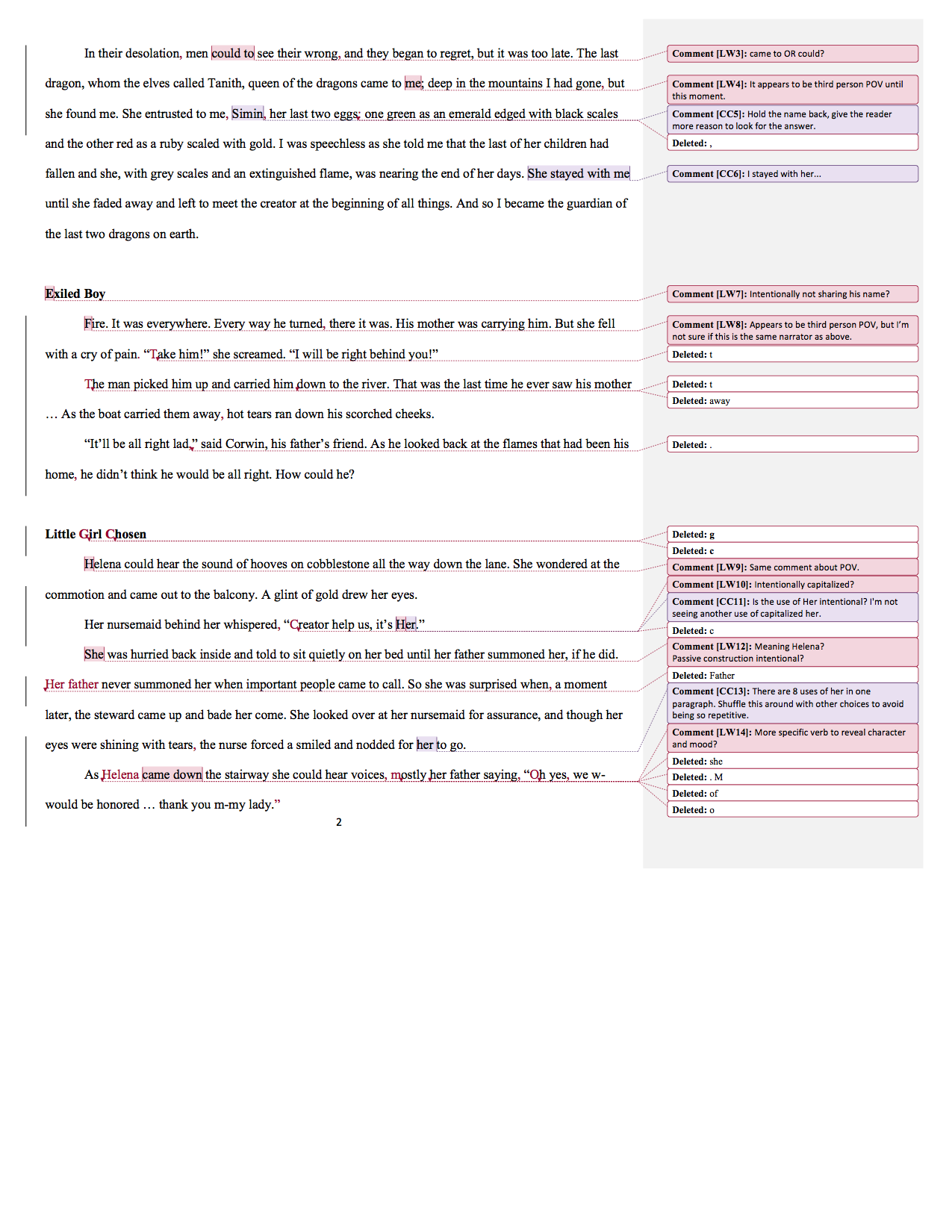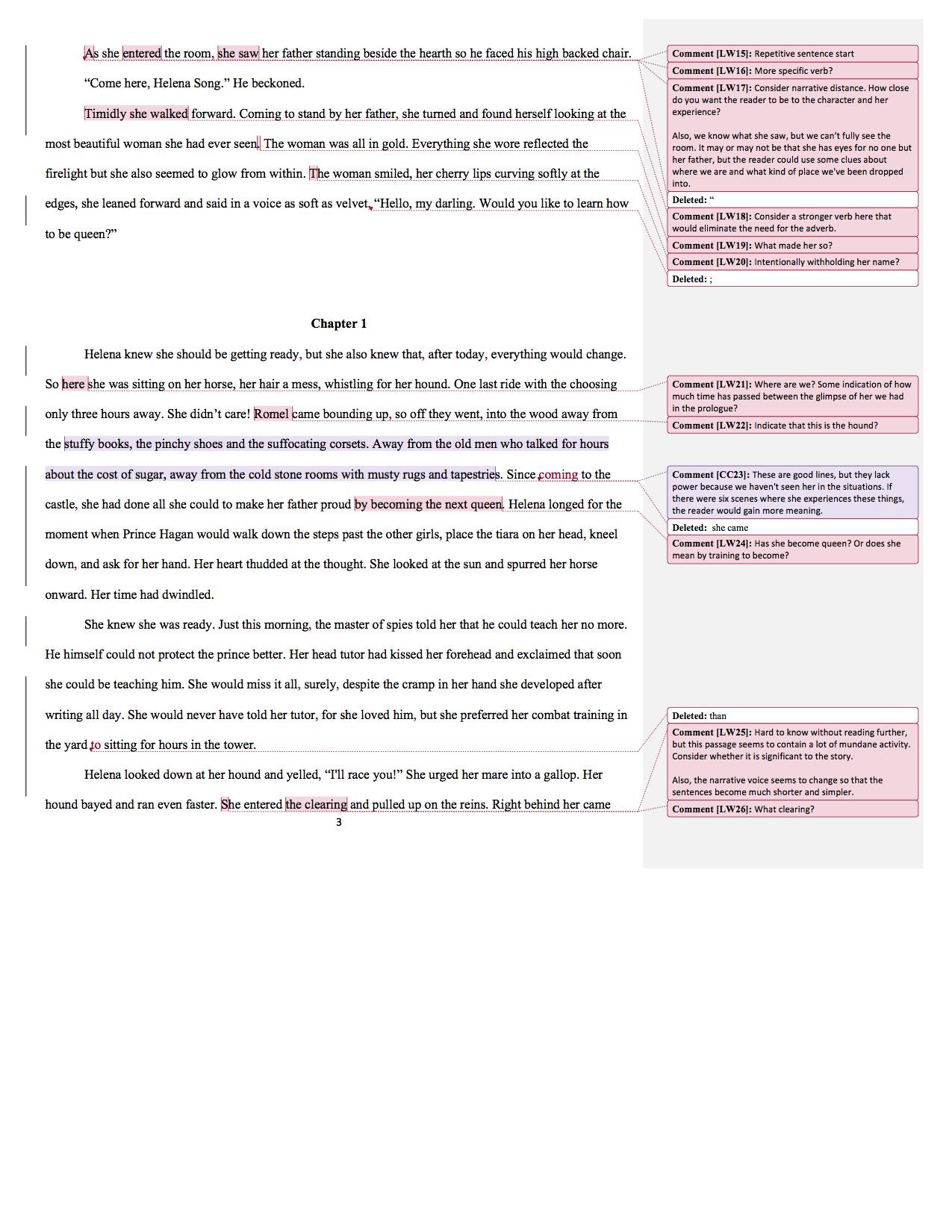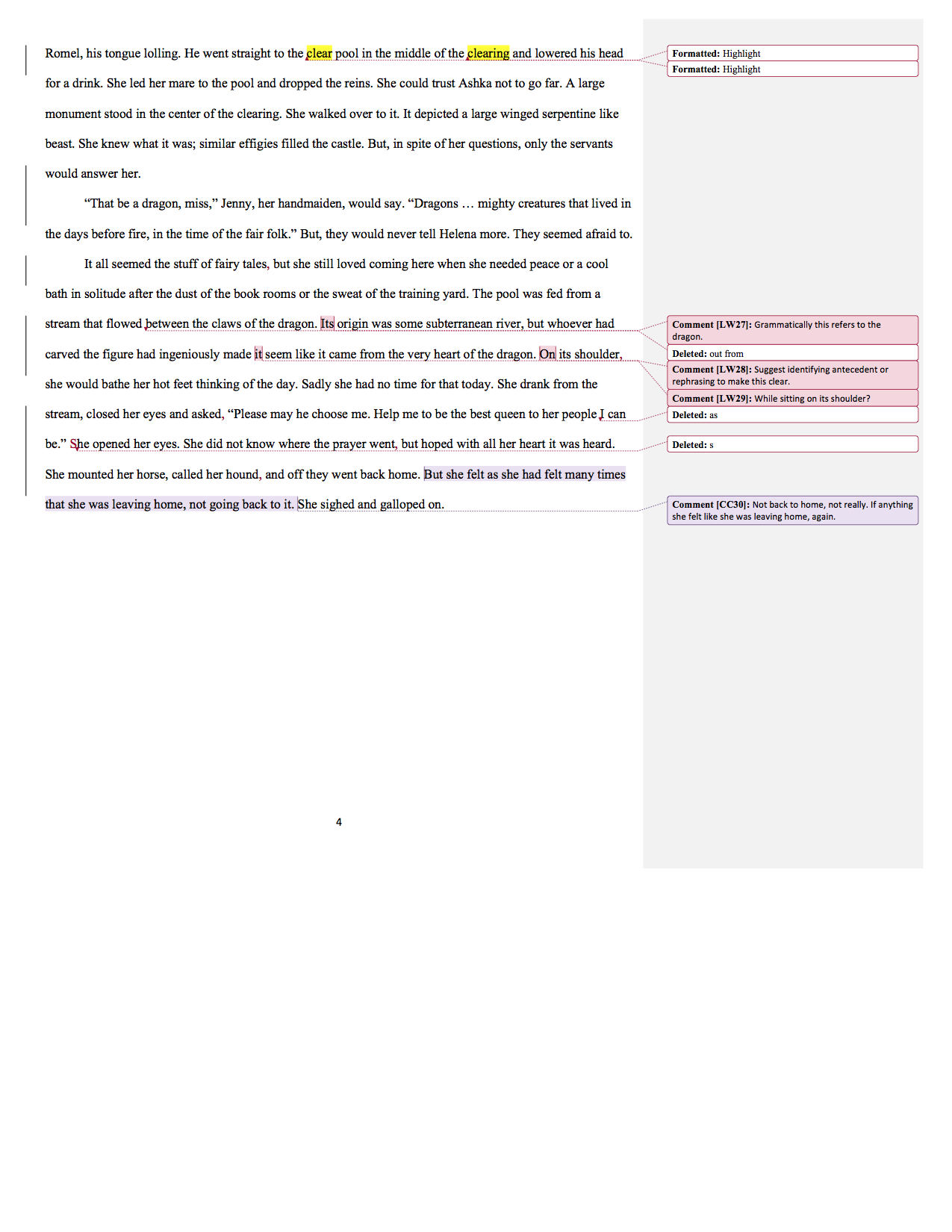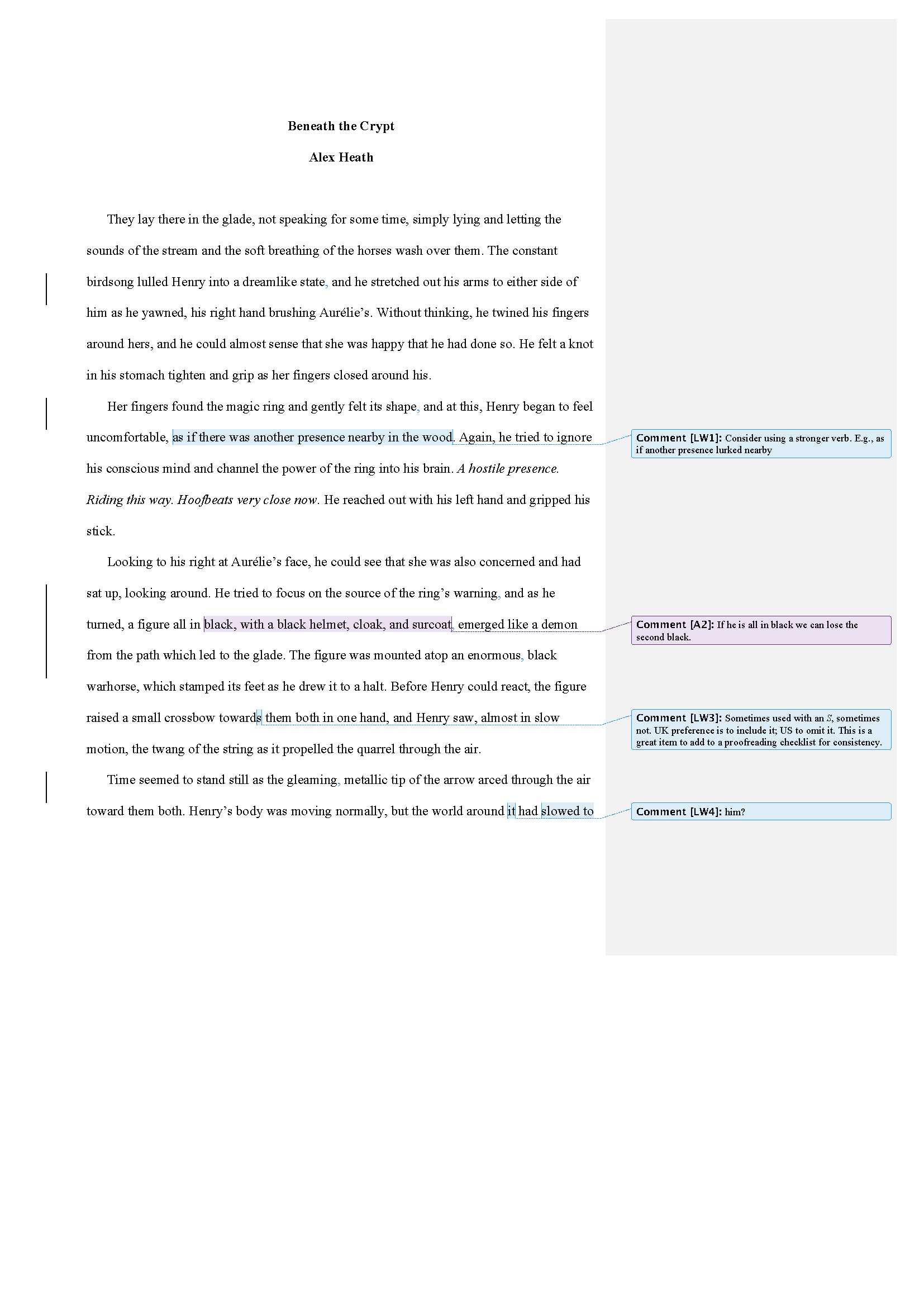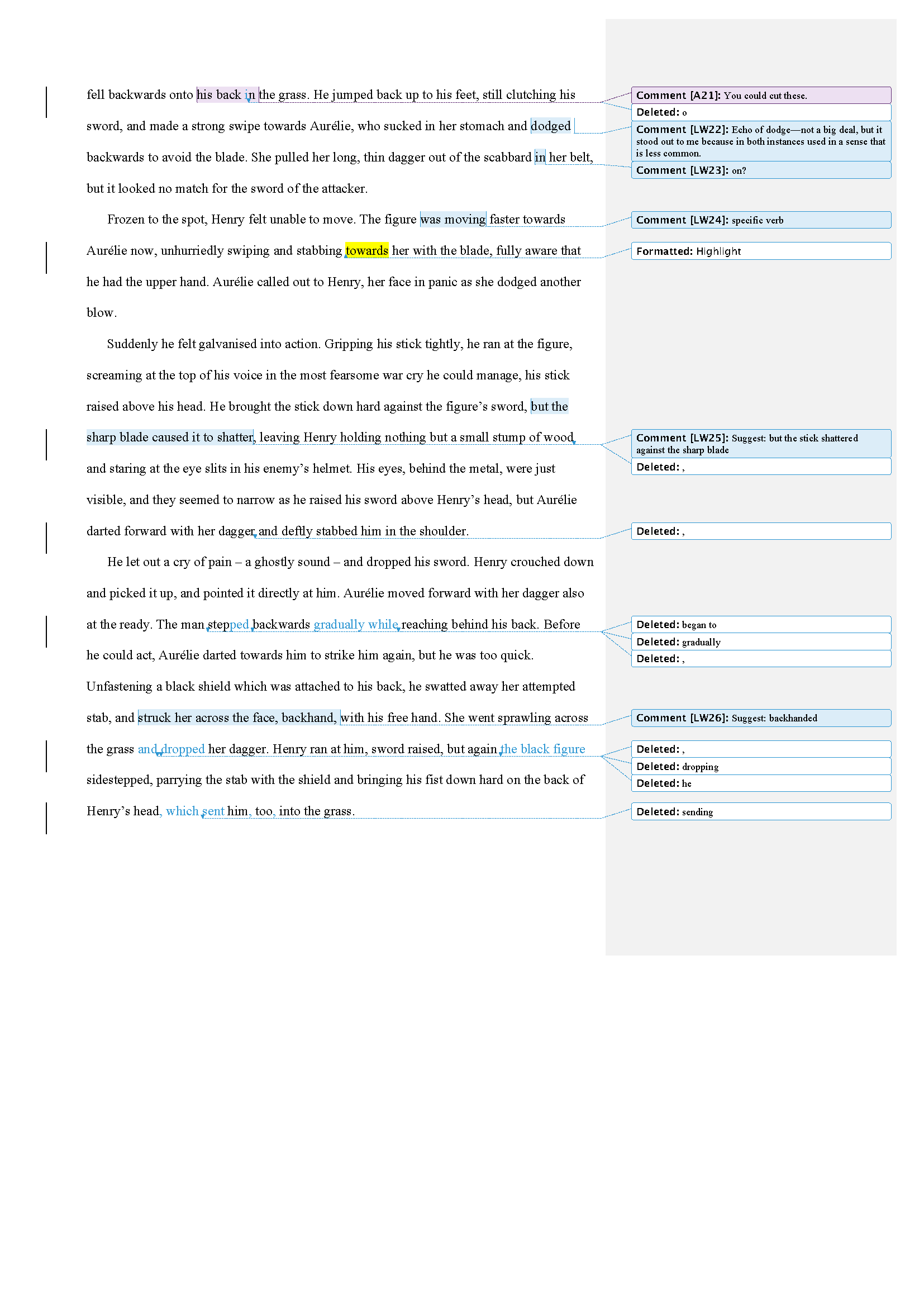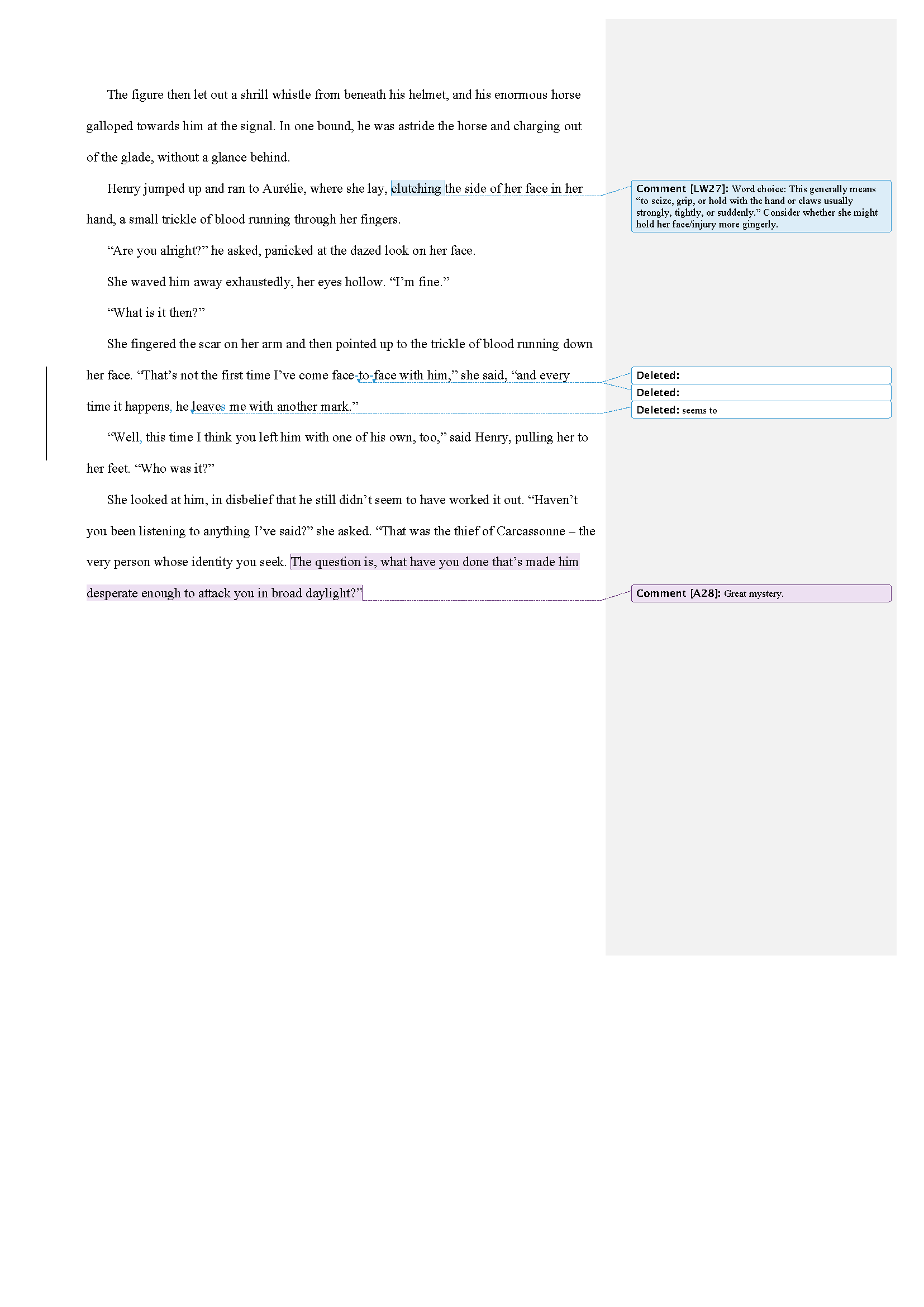Scenes are change through action in conflict within a certain space and time. Crisis questions are the dilemmas that force your characters to decide and act. Listen to episode 120 to find out how to make the most of these scene elements.
Ep. 115: Motivation-Reaction Units
Ep. 113: Intentional Sentence Construction
You have a wide variety of tools to support your story, including the words and sentence structure you choose. The trick is to understand when to use different tools to provide the reading experience you’re aiming for. Listen to this episode to find out how to make the most of your language choices.
Ep. 111: Experiment with Omniscient POV
Ep. 110: Self-Editing Your Fiction
Ep. 109: Where to Begin Your Story
In this episode, fiction editors Leslie and Clark critique the prologue and first chapter of From the Flame, a fantasy novel by Kristen Franklin. They discuss where to begin your story. If all the events of the protagonist’s life were laid out in front of you, which is the most powerful moment to use for chapter one?
Listen to the Writership Podcast
Mentioned in the Show
Hire Clark for your developmental edit! Click here to find out more or email Clark.
Find an illustrated guide to writing scenes and stories here.
Wise Words on Starting Your Story
“But where should you start your story—and when—given that it makes such a difference in the story’s success or failure? For example, right now you’re in a room with a talking penguin, a woman with a gun, and someone hiding behind a potted plant. From your perspective, you might want to rewind events to a point where you can make more sense of it all. However, many writing instructors suggest starting the story as late as possible. What does “late” mean? It often means that moment at which maximum dramatic tension occurs without the loss of so much context about character, setting, and other elements that the drama is meaningless or confusing.”
Editorial Mission—Where to Begin Your Story?
Look at your story as a whole and consider where the protagonist is starting and where she ends up. What are the events that lead up to what happens in the story? Have you shown enough of the ordinary world to allow the reader to perceive the impact of the inciting incident? Have you started too early?
Editing Advice To Our Author
Dear Kristen,
Thank you so much for your submission. Helena is an intriguing character, and the opening of chapter one has me quite curious about her coming adventures. We expect princesses and queens to be trained in certain skills, but these don’t usually include combat and spying. This is a lovely twist that tells us that Helena isn’t a standard potential princess that we’re used to seeing in fantasy novels.
We have some suggestions that we think might make the opening stronger, but I want to preface this with a couple of caveats. This is an early draft, so you hadn’t had the opportunity to review the opening in light of how it ends. The beginning often changes dramatically once we get a better idea of what we’re writing toward.
It’s tricky to make suggestions about where to start, especially when we don’t know what follows, and prologues often don’t make sense at first because the reader is seeing events or characters out of context. Please consider our suggestions as representing options to consider. An editor reviewing your story would read the entire manuscript and understand how the events in the prologue fit.
The History of the World portion of the prologue didn’t seem critical at this point. It was a lot of information when we don’t yet know what’s important. If you refer to a time before the fires without explaining it, you create mystery that can pull the reader forward. It’s tempting to give the reader an explanation of the world when it’s unfamiliar to them, but consider waiting until the facts can provide the greatest impact, where its revelation will bring the protagonist closer to or further from her goal. Readers know they are entering a world different from their own, so you have the luxury to reveal your world strategically.
In Helena’s portion of the prologue, I didn’t feel as pulled into the story as I would have liked. Much as I love Helena as a character, I didn’t feel fully engaged with her until chapter 1. That’s when we get a characteristic moment in Helena’s ordinary world that is moments away from an event that could throw her life into chaos. We see her engaged in an activity she loves and we hear about her training. We also know about the big event to come, which raises all sorts of questions in the reader’s mind. The prince is supposed to choose his future wife, but will he choose Helena or someone else? He could flat out refuse to choose. Some other event could happen that changes everything. These possibilities make for a compelling opening where we’re eager to find out what happens next.
Again, this is something to consider in light of what you know about how the rest of the story unfolds. Thanks again for your submission, Kristen!
All the best,
Leslie
Line Edits for Our Fantasy Story
Image courtesy of kenny001/bigstockphoto.com.
Ep. 104: Revising Your Action Scenes
In this episode, Clark and I critique a scene from Beneath the Crypt, a middle grade fantasy novel by Alex Heath. We talk about how to evaluate and revise your action scenes. When characters fight, chase each other, or engage in acts of derring-do, it can be hard to keep track of all the moving parts. Often, the clear image of how the action unfolds in our minds doesn’t make it into the story. If you unpack what’s happening in your action scene, you can make sure that it does everything you intend, and nothing you don’t.
Listen to the Writership Podcast
Wise Words on Action Scenes
“However, Hollywood films are not good examples of action scenes for books. Action scenes in movies are eye candy, designed to give the viewer a visual “Wow!” at the awesome feats. But all these action scenes flash by in just a few seconds. The viewer doesn’t have time to even think about how impossible that stunt is. In a book, the reader is with that scene a lot longer. She has more opportunity to say, “Wait a minute. They can’t do that.” And the moment she does, you’ve lost her. ”
Additional Resources and Links
Want to find out what Henry did to upset the thief of Carcassone? Read on here.
Clark mentioned that the most realistic fight scene he’s observed is in Old Boy with Josh Brolin.
John Wick with Keanu Reeves is a movie with fight scenes that are realistic in how they portray the combatants’ energy.
To find great examples of dialogue in action scenes, check out Spider-Man comics.
Editorial Mission—Unpack Your Action Scenes
In episode 67, we asked you to look at model fight and other action scenes to help you revise your work. This week, we want you to unpack your own action scenes.
Use an action scene you’ve written and record what you observe in a list of what happens in the scene. Add every instance, one per line, of the following:
- action a character takes (e.g., character throws a punch)
- piece of information that’s revealed (e.g., character notices the bad guy has a knife)
- result or consequence (e.g., man falls to the ground)
Once you’ve exhausted everything you can think of about the scene, put the items in chronological order. Here’s an example:
- Fred slashed at Joe’s face with his knife.
- Joe ducked under Fred’s arm.
- Joe kicked the side of Fred’s right knee.
- Fred shouted.
- Fred fell to the ground.
- Fred dropped the knife.
- Joe grabbed Fred’s wrist with both hands.
- Joe twisted Fred’s wrist.
- Joe felt the bones crack.
- Joe felt relieved.
- Joe saw Fred’s friend walking toward him.
This is a simplistic list, but it will give you a clear view of what you have and what you need. When you're done, review the list and ask yourself these questions:
- Does it make sense?
- Have you missed any crucial actions, pieces of information, or results?
- Does each element appear in the best place in the sequence?
Next, consider the setting and where people and objects are, especially in relation to one another. I recommend drawing a diagram and using small tokens (I use Lego minifigures) to show keep track of people and objects, especially if you have a battle or an action/fight scene that involves more than two or three people.
Think about visibility. Is it a crowded street, the woods at night? What can your POV character actually observe (sights and sounds)? Does this affect the action as you’ve laid it out?
Once you’ve done all this, then revise your scene. You could approach this in different ways. You could use your new understanding of the scene to revise the one you’ve already written, write it from scratch, or begin weaving the sentences in the list together into a scene.
Why go through all this work? Action scenes are intense, fast-paced, and often contain several different elements. Sometimes the author has such a clear vision of the scene as a whole, as if it’s a video playing in their minds, that they don’t see and record the individual elements to transfer that conception to the reader’s mind. Unpacking what you’ve put on the page can help you discover if anything is missing.
Please remember this is a tool for revision! I wouldn’t mess with the minutiae while writing an early draft, but when you review it, if you deconstruct the action this way, you can be sure that what you imagine in your mind’s eye ends up in the story.
Editing Advice to Our Author
Dear Alex,
Thanks so much for your submission! Beneath the Crypt sounds like a fun adventure story, and Henry and Aurélie are great characters to play with. Even though we’re jumping into the middle of the story with no other introduction to the characters, it was easy to follow. The approach of the mysterious figure is a great hook to pull us into this scene, and the open question you leave us with at the end of the scene is intriguing and would make it hard to put the book down.
Clark and I focused on action scenes for this episode, and I think you’ve done a nice job of conveying who is doing what, where, and when, which as we mention in the episode can be a bit tricky. Although combatants in a fight don’t have time for a lot of reflection (unless one is skilled and facing an unworthy opponent), I think you could make the scene stronger with more reaction from Henry. I’d love to know about Henry’s experience in the fight, what he’s feeling physically and emotionally, and how he reacts what’s unfolding.
One example is when the thief faces Henry, and we get a pretty good look at the black-clad figure through Henry’s POV—with the exception of his face, of course. We see what he’s wearing, that the only armor he’s employed is a helmet, and that he is thin and lightly built (which could possibly clue the reader in to his identity or not depending on your intent and what you’ve revealed before this scene). We also see his weapon and that he is advancing on Henry with apparent violent intent. In the next paragraph, we see that Henry is scared and not sure what to do, but don’t know if he is generally scared or if something he’s seen and concluded about his opponent evoked the reaction. If you were to weave in a direct connection between his observations and what he does, the details you reveal would be immediately relevant to the scene before us rather than only the description of a character.
We noticed that you don’t have a lot of dialogue in the scene, and that may be in part due to what’s happening. As it opens, Henry and Aurélie are resting and wouldn’t necessarily be speaking. The thief is trying to avoid revealing is identity, so he might not want to speak if his voice is distinctive. Consider if there are opportunities when Henry or Aurélie might say a word or two periodically to break up the narrative and alter the pace.
We can’t assess this from only one scene, but wanted to mention this because it’s important in fantasy stories. The magic used in an action scene should be consistent with how magic is used in the story world in general. This is a helpful item to add to a revision checklist for anyone who writes speculative fiction.
For picky stuff, we flagged a few echoes and awkward phrasing in our comments. We spotted some places where specific verbs would enable you to cut some adverbs.
Note: We’ve labelled this middle grade fiction, but other factors within the story could tip it into young adult.
We appreciate your sharing this entertaining scene with us, Alex! Thanks again for trusting us with your words!
All the best,
Leslie & Clark
Line Edits for Our Mystery Story
Image courtesy of NejroN Phot/bigstockphoto.com.



